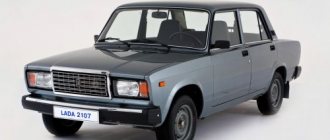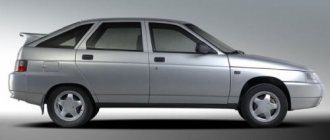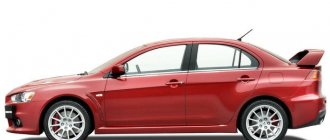The fuel consumption of the VAZ 2107 per 100 km depends on many factors. These include the following: vehicle speed, engine type and fuel supply system. What is the fuel consumption of a VAZ 2107 with a carburetor? According to documents for this model of car, the average fuel consumption on the highway is 6.8 liters, if the speed is about 90 km/h. P When driving in city mode, this figure increases significantly - up to 9.6 liters.
What you need to know to reduce fuel consumption
Checking the air damper in the carburetor
Higher fuel consumption on a VAZ 2107 with a carburetor engine occurs if the air damper is not fully open. What is its correct position? Surely, an experienced driver knows that when the engine in the car is running, the choke in the carburetor must be in a vertical position. The choke handle must be fully extended towards you. Fuel consumption at idle speed in the VAZ 2107 can be reduced by specially setting the carburetor air damper to some extent. But such manipulation is not effective enough.
| Engine | Consumption (highway) | Consumption (city) | Consumption (mixed cycle) |
| 1.3 l 4-mech (gasoline) | 7.8 l/100 km | 11.5 l/100 km | 10.5 l/100 km |
| 1.4 l 5-mech (gasoline) | — | 9 l/100 km | — |
| 1.5 l 5-mech (gasoline) | 5.2 l/100 km | 8.9 l/100 km | 7 l/100 km |
| 1.6 l 5-mech (gasoline) | — | 8.5 l/100 km | — |
| 1.3 l 5-mech (gasoline) | 9.5 l/100 km | 12.5 l/100 km | 11 l/100 km |
The reasons for the high fuel consumption on VAZ 2107, the carburetor of which is in a faulty condition, speak for themselves. Young drivers do not always take the time to thoroughly check their car, and this can lead to negative consequences. Other factors of uneconomical fuel consumption may include:
- incorrect speedometer readings;
- malfunction of the device that measures the level of gasoline in the tank;
- driver's driving style.
VAZ 2107: fuel consumption per 100 km
The VAZ-2107 was equipped with various engines depending on the configuration, and the following models were produced with carburetor engines:
- 2107 – ICE 2103 1.5 l;
- 21071 – ICE 2101 1.2 l;
- 21072 – ICE 2105 1.3 l;
- 21074 – ICE 2106 1.6 l.
Fuel consumption (FC) on cars with carburetor power units depends on the engine size - the smaller the cylinder volume, the less fuel should be consumed. According to the technical data of the VAZ-2107 car, fuel consumption per 100 km is:
- on the highway – 6.8 l (at a speed of 90 km/h);
- in city mode - 9.6 l.
RT increases sharply with increasing speed, so at 120 km/h per 100 km 9.5 liters of gasoline are consumed. For a VAZ-21074 car with a 2106 engine, the RT standards are slightly different:
- outside the city – 6.9 l/100 km;
- within city limits – 10.2 l/100 km.
In the combined fuel cycle, 9.2 liters are consumed per “hundred”. It is also worth noting that cars with a five-speed manual transmission are more economical than cars with a 4-speed gearbox.
Checking the fuel jet
Also, the reason for the high consumption of gasoline on a VAZ can be the fuel nozzle if its holder is not tightly enclosed. Because of this, during different engine operating modes, much more fuel enters the cylinders than required by the norm. To avoid this situation, check the tightness of the holder. You cannot tighten it too much, but even if it is not tightened completely, this will lead to the fact that the holder can randomly turn out while the machine engine is running. The reason for the overconsumption is that the diameter of the jets is too large or they are dirty.
VAZ 2107 1.5 injector
There were 2 configurations of the VAZ 2107 with a 1.5 liter injection engine: with a power of 68 (2002-2006) and 72 hp. (1982-2006). Regardless of power, the maximum speed and other data were the same: maximum speed 150 km/h, acceleration time to hundreds - 17 seconds, average fuel consumption - 8.5 liters (8.9 liters in city mode, 7.4 liters outside the city).
Other cars: Opel Meriva fuel consumption
Fuel consumption per 100 km reviews
- Ostap, Sevastopol. If you need to learn how to drive and not think about possible damage, then the 2107 is an ideal option. I have a 2004 build (72 hp), so I just haven’t done anything to the car. It eats absolutely any gasoline, consuming 9.5 liters in the city and a little less than 8 on the highway. In winter, the appetite wakes up, but rarely exceeds 10 liters on average.
- Stanislav, Vladimir. We can talk about the pros and cons of the domestic automobile industry for a long time, but the fact remains that our cars last longer than foreign cars. I bought my VAZ 2107 in 2010 with a mileage of 120 thousand (built back in 1989). It doesn’t break down, the consumption is always predictable: city/highway – 9.3/7.8. On a full tank I can get up to 370 km. The main disadvantage is the complete lack of comfort in the cabin.
- Innokenty, Kazan. VAZ 2107 1.5 (68 hp). I am the third owner and, I feel, not the last - the car is not afraid of potholes, fire, or the end of the world. It will pass everywhere, while eating 9-9.5 liters of any gasoline in a mixed cycle. On the highway it generally turns out to be 7.6, but they say that carburetor versions are better.
- Andrey, Moscow. I've been driving a taxi slowly for 2107 for the 5th year now. The car is tired, but not capricious. I have already changed a lot of things, cleaned the engine, and for this the car gratefully drives every next 100 km with a consumption of up to 11 liters in the city. I won’t say outside the city - I don’t go out often. The main disadvantage is the uncomfortable seats and small interior. Built in 2003, mileage 57 thousand.
- Victor, Astrakhan. We took this Lada to a pizza delivery company. Cheap to maintain, easy on fuel and driveable - what more do you need from a company car? We repair it ourselves (try fixing a foreign car yourself!) when necessary. Gasoline consumption on an injection engine rarely exceeds 9.5-10.5 liters in the city. Warming up on frosty days increases the figure to 12 liters, but this is not critical.
Excessive fuel consumption on the injector
Owners of new modified VAZ cars with a single electronic control unit may encounter excessive consumption of gasoline at the injector. One of the reasons may be incorrect pressure in the fuel system. Recheck the car's engine management system; there may be a malfunction in its operation.
Also, one of the key problems with fuel consumption can be the failure of an injector or temperature or oxygen sensor. The fuel consumption of a Lada 2107 per 100 km with an injector (engine volume 1.5 liters) in the city in winter should be 9.5-13 liters, and in summer – 7.5-8.5 liters.
Do these digital indicators correspond to reality?
Based on reviews from VAZ-2107 car owners, the difference between the declared characteristics from the manufacturer of a car of this model, which relate to gasoline consumption, averages 1-1.5 liters (per 100 kilometers).
Experts have created a summary information table “Comparison of real and official digital fuel consumption indicators for the VAZ-2107” (information taken from the website “Fuel Control - real fuel consumption of cars” - https://fuelcontrol.info/services/model/noclass/LADA% 2B2107).
| Mode | on the road | around town | mixed | idle | off-road |
| official data | 9,2 | 9,7 | 8,5 | – | – |
| real data in summer | 7,5 | 10 | 8,6 | 3,5 | 9 |
| real data in winter | 8 | 10,5 | 9 | 7,5 | 10 |
| average data (in fact) | 7,75 | 10,25 | 8,82 | 5,5 | 9,5 |
What needs to be done to optimize fuel consumption
Try to drive without sudden braking or sudden acceleration. To ensure that the actual consumption of the VAZ 2107 does not exceed the norm, replace the use of mineral motor oil with synthetic one.
Check your vehicle regularly and replace the air filter if necessary.
Gasoline consumption 2107 per 100 km (and regardless of the kilometers traveled) at normal vehicle speed also depends on the quality of the fuel, so try to purchase it at large network gas stations. The saving of fuel and your financial resources depends on the technical condition of the car.
We diagnose ourselves
You can find out for yourself how much fuel is actually consumed.
To do this, you need to fill a full tank of gasoline, which is 39 liters, and drive until the gas level indicator is in the middle. This will take more than one hour of moderate driving. Then we go back to the gas station.
We calculate: divide the volume of fuel poured by the mileage on the odometer. This way you will find out the average gasoline consumption of a VAZ 2107 per 100 km. If fuel consumption standards are exceeded, you yourself will not be able to diagnose the exact cause of the problem. Then it is recommended to go to a service station.
Fuel consumption standards for VAZ 2107
As you know, the VAZ 2107 was equipped with different engines at different times.
Consequently, fuel consumption rates also changed. This is what it looked like:
- Initially, the VAZ 2107 was produced only in a carburetor version and was equipped with a one and a half liter 2103 engine, the power of which was 75 hp. With. When driving around the city, the first carburetor “sevens” consumed 11.2 liters of gasoline, and when driving on the highway this figure dropped to 9 liters;
- in 2005, instead of a carburetor engine, the “Seven” began to be equipped with a one and a half liter injection engine of the 2104 brand. Its power was lower than that of its predecessor and amounted to 72 hp. With. Fuel consumption was also lower. In the city, the first injection “sevens” consumed an average of 8.5 liters per 100 km. When driving on the highway - 7.2 liters per 100 km;
- finally, in 2008, the “seven” received another engine - the modernized 21067, which is by far the most popular. The volume of this engine is 1.6 liters, power - 74 liters. With. As a result, fuel consumption of the latest fuel-injected “sevens” has increased again: in the city 9.8 liters, on the highway - 7.4 liters per 100 km.
Climate and consumption rates
The climate in which the machine is operated is the most important factor affecting fuel consumption. It is impossible not to mention this factor. In winter in the southern regions of our country, average fuel consumption can vary from 8.9 to 9.1 liters per 100 km. In the central regions, this figure varies from 9.3 to 9.5 liters per 100 km. Finally, in the northern regions, winter fuel consumption can reach 10 liters or more per 100 km.
Vehicle age
The age of the car is another factor that many car enthusiasts often overlook. It’s simple: the older your “seven” is, the greater its “appetite”. For example, for cars older than five years with a mileage of more than 100 thousand km, the average fuel consumption is 8.9 liters per 100 km. And if the car is more than eight years old and its mileage exceeds 150 thousand km, then such a car will consume an average of 9.3 liters per 100 km.
VAZ 2107 1.6 carburetor
The carburetor version of the 1.6-liter engine was almost no different from the injection one. The same average gasoline consumption is 8.5 liters with a 75-horsepower power plant under the hood. Maximum acceleration is the traditional 150 km/h with an average fuel consumption of 8.5 liters. The car accelerates to 100 km/h from zero in 15 seconds. The Lada 1.6 MT with a carburetor was produced from 1982 to 2006.
Fuel consumption rate per 100 km
- Ivan, Kharkov. I spent a long time choosing between a carburetor and an injector. In the end, I settled on an injector - friends said it would be more economical. And so it happened - consumption in the city is 10 liters, and on the highway 7 liters. On average, as the manufacturer promises, it comes out to 9 liters. The interior is not particularly good, but it will go where expensive foreign cars cannot cope.
- Eduard, Ulyanovsk. My brother and I bought a 2005 Lada 2107 with 12,000 miles between us. The car was after an accident, we restored everything ourselves. Gasoline consumption is higher than standard (we have up to 12-13 liters in the city), but we drive mainly on the highway, where at a speed of 100 km/h the engine consumes only 7 liters.
- Vsevolod, Vyborg. I bought a used 1990 Lada for pennies - I needed it for work. The purchase was fully justified - an economical and reliable car, 6-7 liters on the highway at speeds up to 100 km/h. If you don't drive, you can get around the city in 8. In general, I’m not particularly worried about consumption - 18 liters per 250 km is enough.
- Gennady, Ufa. I bought a 2006 VAZ from a colleague while it was still under warranty. The carburetor turned out to be the weakest point of the Lada; it took a lot of nerves to stretch the fuel consumption to adequate levels. Depending on the speed of movement and the time of year, the average consumption in the city is now 8.7-9.5 liters.
- Egor, Norilsk. What happens when you get your hands on a car with 100,000 miles? Absolutely nothing with the 2107th Lada! Consumption, as stated, is 9-11 liters in the city, and so it is. On the highway at high speed from 8 to 10 liters (4th gear, 120 km/h). I fill up whenever I need something, because the car eats both 92nd and 95th gasoline equally well.
Other cars: Renault Traffic fuel consumption
VAZ 2107 1.6 injector
The Lada 2107 version with an injection engine was produced from 2002 to 2012 and gained quite a lot of popularity in the market. Technical data: maximum speed – 150-155 km/h, acceleration to 100 km/h in 15-16 seconds, engine power – 74 hp, average fuel consumption, as in previous trim levels, – 8.5 liters (9.7- 9.8 liters in the city and 6.8-7.3 liters on the highway).
Reviews about fuel consumption
- Sergey, Makhachkala. My Lada has already outlived its usefulness. I bought a new one in 2002 with an injector, didn’t regret it at all, but it’s still running. Paint it, clean it, repair it, and it will be as good as new. The engine works like a clock, eating the same 10-12 liters in the city and 10 on the highway as at the very beginning of operation.
- Nikolay, Derbent. For a novice driver, there is no better car “simulator”; sit down and go ahead and learn the basics of driving. I fill my VAZ with whatever is at hand, because this car does not test the quality of gasoline and oil. The fuel consumption is not surprising at all - the manufacturers said 8.5 liters in a mixed mixture and it is so. In the city around 10 liters in summer and 12 in winter.
- Dmitry, Belgorod. This car has already become a family heirloom. Grandfather bought a new one in 2002, dad got a Lada in 2010, and now I drive a taxi. An excellent car for family outings or fishing - it will fit anywhere and in any conditions. Consumption is standard for this model - 9 liters in the combined cycle. In the city I get 12 liters, since I often go out for short distances.
- Yuri, Pskov. VAZ (Lada) 2107, injector, model 2005. I have never seen a cooler gearbox than on the Lada. Clear switching, precise engine operation, clear limits on gasoline consumption. A full tank takes 340-360 liters, depending on the time of year. The average consumption on the highway is 7.5 liters, and in the city it turns out to be 11 or less.
- Anna, Kemerovo. For a long time I used it for trips to buy goods and I had no problems with this machine. I had to change it to something newer, but I remembered the Lada 2107 forever - a trouble-free engine and a stable average consumption of 9 liters in the summer. In cold weather, the stove was a lifesaver, even though it took 11 liters of gasoline.
Other cars: Chevrolet Epica fuel consumption











